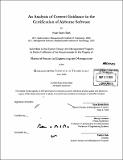| dc.contributor.advisor | Nancy Leveson. | en_US |
| dc.contributor.author | Berk, Ryan Erwin | en_US |
| dc.contributor.other | System Design and Management Program. | en_US |
| dc.date.accessioned | 2010-05-25T21:03:59Z | |
| dc.date.available | 2010-05-25T21:03:59Z | |
| dc.date.copyright | 2009 | en_US |
| dc.date.issued | 2009 | en_US |
| dc.identifier.uri | http://hdl.handle.net/1721.1/55204 | |
| dc.description | Thesis (S.M.)--Massachusetts Institute of Technology, System Design and Management Program, 2009. | en_US |
| dc.description | Cataloged from PDF version of thesis. | en_US |
| dc.description | Includes bibliographical references (p. 89-91). | en_US |
| dc.description.abstract | The use of software in commercial aviation has expanded over the last two decades, moving from commercial passenger transport down into single-engine piston aircraft. The most comprehensive and recent official guidance on software certification guidelines was approved in 1992 as DO-178B, before the widespread use of object-oriented design and complex aircraft systems integration in general aviation (GA). The new technologies present problems not foreseen by the original guidance material and may complicate demonstration of compliance with such guidance material. The Federal Aviation Administration has deferred to industry experts in the form of the Radio Technical Commission for Aeronautics (RTCA) and the Society of Automotive Engineers (SAE) to create software and system approval guidance. The FAA's Advisory Circular (AC) 23.1309- 1C created a four-tier approval system to reduce software and system approval burden on smaller aircraft, creating a lower standard for small aircraft in the hopes that safety gains from technology would outweigh the potential cost of defects from less stringent requirements. Further guidance regarding the role of software in the overall system is spread across other documents including Aerospace Recommended Practice (ARP) 4754, ARP 4761, and applicable SAE Aerospace Standards (AS). The guidance material, spread across several documents, lacks sufficient specificity to be of use to an everyday practitioner. In addition the guidelines are not necessarily rigorously enforced when the same artifacts are required at different levels of design assurance as stated within DO-178B itself. | en_US |
| dc.description.abstract | (cont.) After a literature review and regulatory analysis, this thesis investigates some example defects that escaped detection during application of the guidance in a real-world product, making specific recommendations to improve the guidance in a usable way. | en_US |
| dc.description.statementofresponsibility | by Ryan Erwin Berk. | en_US |
| dc.format.extent | 91 p. | en_US |
| dc.language.iso | eng | en_US |
| dc.publisher | Massachusetts Institute of Technology | en_US |
| dc.rights | M.I.T. theses are protected by
copyright. They may be viewed from this source for any purpose, but
reproduction or distribution in any format is prohibited without written
permission. See provided URL for inquiries about permission. | en_US |
| dc.rights.uri | http://dspace.mit.edu/handle/1721.1/7582 | en_US |
| dc.subject | System Design and Management Program. | en_US |
| dc.title | An analysis of current guidance in the certification of airborne software | en_US |
| dc.type | Thesis | en_US |
| dc.description.degree | S.M. | en_US |
| dc.contributor.department | System Design and Management Program. | en_US |
| dc.identifier.oclc | 609413262 | en_US |
